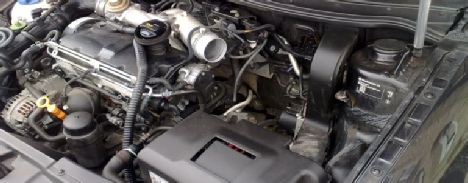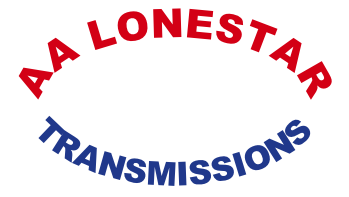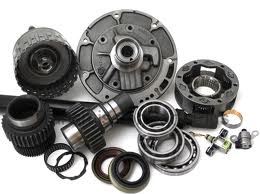
I’m facing a costly repair?
The Check Engine light can mean many things -
from a loose gas cap to a serious misfire in your
Engine. Certainly you don’t need to pull to the side
of the road and call for a tow, however, it
Shouldn’t be ignored for long either. The light is
part of your vehicle’s onboard diagnostic system.
Since the 1980’s, computers have increasingly
controlled and monitored vehicle performance,
Regulating engine speed, ignition timing, fuel
mixture and more. When it finds a problem that
it can’t correct, it triggers the warning light.
AA Lonestar offers a free computer diagnosis so if
your check engine light is on, bring your vehicle to
us for a comprehensive inspection.
Why can’t I get a price for my transmission repair over the phone?
20 or so years ago, there were only maybe a dozen different types of transmissions on the road.
Every repair shop had a nice inventory of rebuilt units in supply. Today there are more than ten times
that many transmissions in use, with new ones showing up constantly. Many of those transmissions
have several variations or calibrations, with as many as a dozen modifications necessary. Also,
today’s transmissions are computer controlled, meaning that even though you may be seeing and
feeling the symptoms of transmission failure, there’s a good chance that the cause of the problem
isn’t even with your transmission. Our technicians have to perform a series of tasks on your vehicle
in order to give you an accurate assessment. Beware of shops who quote you a price over the
phone, as it’s truly impossible to price a transmission repair/replacement without first inspecting
the vehicle.
Unfortunately it’s true, transmission repair can be expensive. Today’s transmissions consist of
thousands of individual components, which during a major repair, have to be individually removed,
inspected, and cleaned or replaced. Then each part is put together into one of many sub-assemblies,
which must be adjusted and tested. These sub-assemblies are then assembled together into the
transmission case where the adjustment procedure begins all over again. Remember that the longer
you continue to drive your vehicle with symptoms of transmission problems, the more damage you
could (and probably are) be doing to your transmission components. More damage equals higher
repair bill, so bring your vehicle to AA Lonestar at the first sign of trouble!
problem, and getting your vehicle into
a repair shop can save you hundreds of
Dollars.
Transmission slippage, where the
transmission slips in and out of gear, is
a classic sign of trouble.
Transmission Spinning, where the transmission spins without providing vehicle movement, can
happen when the clutch fails to engage the transmission gears with the engine crankshaft.
Transmission lag - a delay in transmission action - can happen during acceleration from a
complete stop. Seeing a pinkish fluid on your driveway is a sure sign that you need to get your
car to a repair shop immediately. This is a sign that you have a transmission fluid leak, and
ignoring it could cost you more later down the road.
AA Lonestar offers transmission service at a reasonable price to keep you in
your vehicle longer. If you are experiencing any of the symptoms listed above, bring your vehicle
to us - we’ll give you a free estimate of repairs.
is going bad?

There are some terrific advantages to driving an old car, including cheaper car insura nce
and owning your car outright. But old cars need repairs, especially those that are
five years old or older. So when you are suddenly faced with a costly repair for
your old car, does it make more sense to repair it or replace it with a new car?
nce
and owning your car outright. But old cars need repairs, especially those that are
five years old or older. So when you are suddenly faced with a costly repair for
your old car, does it make more sense to repair it or replace it with a new car?
While it's almost always cheaper to repair your used car instead of buying a new one, you need more information before you can make a solid financial decision. Find out the answers to these questions:
How much is your car worth? Check the value of your current car at several third-party car information websites such as Edmunds.com, Kelley Blue Book or NADAguides.com to determine what it's worth, assuming it's working properly.
What would it cost to replace it? Assume for a moment that if you replaced your old car, you'd buy a new car that's a similar make and model. Do a bit of research online to determine what the new car would cost. Chances are it's at least $20,000 and possibly a lot more. Then use Bankrate's auto loan calculator to estimate your monthly payment.
How much does the repair cost?
Once you have these three numbers, you are better equipped to make a smart financial decision. If the repair cost greatly exceeds your car's value, it is probably best to replace your old car. From a financial perspective, it's wisest to replace the car with a newer, but used car to avoid the huge depreciation hit that happens when you buy a brand new car. It's also a good idea to sell your old car in a private-party sale to get the largest amount for your car. Just be sure to fully disclose the repair that needs to be completed.
With repairs that are roughly equal to the value of your used car or less, it makes better financial sense to make the repair versus buy a new car, since even the most expensive repairs would most likely only equal about a year of car payments on a new car.
Today, most new cars are built to last 200,000 miles or more, with a few more expensive items often needing repair at the 100,000- to 120,000-mile mark. Once your car is paid off, put aside an amount that equals about 20 percent of what your car payment was each month for repairs. This money can be used for any necessary repairs, and any excess will make a nice down payment for your next car when you're ready to buy one. - Courtesy of Bankrate.com
Head Gaskets
A head gasket can fail for a number of reasons, none of them good. Engine overheating is the most popular culprit. The metal of the engine block and head expands beyond limits during overheating. This expansion can pinch the head gasket to the point where it will fail. The next major causes of head gasket failure are engine pre-ignition or detonation. The crux of these two conditions is out-of-time combustion occurring in the cylinders. Internal combustion is supposed to occur with both valves closed and with the piston at the top of its power stroke. Out of time combustion puts extra strain on the valves, pistons, and head gasket. Ironically, engine overheating can also increase the likelihood of pre-ignition and detonation. The sound of an engine pinging or knocking is the insidious sound of damage.


Your brakes should be inspected every 30,000 to 40,000 miles depending on your driving habits.
However, if you have any of these signs, you should bring your vehicle in immediately:
Grinding noises - if you hear a grinding sound when you apply your brakes, changes are your brake
pads are worn and are needing replaced.
Pulsating sounds - a pulsating, pounding sound means you may have a problem with your rotors.
Pressure problems - if you press your brake and there is little or no pressure, you’ve got brake
fluid issues, or there could be air or a leak in the brake fluid line.
AA Lonestar Transmissions offers a variety of brake pad options from low cost replacement
pads to pads that come with a lifetime warranty, depending on your financial situation.
It's impossible to say exactly which parts will need to be replaced in your transmission until we have had a chance to disassemble the unit and look inside. Every transmission rebuild requires the installation of the Master Overhaul Kit (pictured right) which includes clutches, plates, bands, bushings, thrush washers, piston lip seals, gaskets, filter and external seals. If you have continued to drive your vehicle after symptoms of transmission problems occurred, you may have hard part damage which is not included in the master kit and which would be more expensive. You can be sure that AA Lonestar technicians will explain all damage to you and give you an estimate based on the damage we find.
Your vehicles shocks and struts may not be readily visible, but they play a major role in steering, stopping, and stability. They are critical to the safe operation of your vehicle and should be replaced about every 50,000 miles. Without fully functional shocks and struts, a vehicles
tires can lose traction, leading to reduced steering and braking control.
AA Lonestar Transmissions offers competitive pricing on shock and strut replacement and a lifetime warranty is available for an additional charge. Call us today for a quote for your vehicle.
How Car Suspensions Work - courtesy of How Stuff Works
When people think of automobile performance, they normally think of horsepower, torque and zero-to-60 acceleration. But all of the power generated by a piston engine is useless if the driver can't control the car. That's why automobile engineers turned their attention to the suspension system almost as soon as they had mastered the four-stroke internal combustion engine.
The job of a car suspension is to maximize the friction between the tires and the road surface, to provide steering stability with good handling and to ensure the comfort of the passengers.

817-244-8473
Serving the greater Fort Worth area
817-563-5353
Serving Arlington/Mansfield/Kennedale

| Engines |
| Transmissions |
| Timing Belts & Water Pumps |
| Cylinder Heads & Head Gaskets |
| Suspension |
| Radiators |
| Brakes |
| A/C & Heating |
| Diesel Engines |
